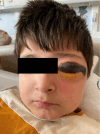A Rare Presentation of Anthrax: A Pediatric Patient with Palpebral Anthrax
- PMID: 38808049
- PMCID: PMC11128698
- DOI: 10.14744/SEMB.2023.51261
A Rare Presentation of Anthrax: A Pediatric Patient with Palpebral Anthrax
Abstract
Anthrax is a rare zoonotic disease in humans caused by Bacillus anthracis. The most common form of this disease is cutaneous anthrax. Rarely, eye involvement may occur. In this case, a nine-year-old male patient with anthrax on his left eyelids is presented. From the patient's history, it was learned that a slight papular reaction occurred on the left side of the eye, then the lesion enlarged within three days, and edema developed around the eye. On the fifth day of the patient's preseptal cellulitis diagnosis, progress in eye lesions and necrosis and eschar formation around the eyes were detected, while Bacillus anthracis polymerase chain reaction (PCR) positivity was detected on the fifth day of the patient's complaints. The patient was treated with ciprofloxacin and clindamycin and a clinical response was achieved. Anthrax should be kept in mind in the differential diagnosis of preseptal and orbital cellulitis, especially in patients who have close contact with animals. If palpebral anthrax is not treated effectively on time, it can leave scars on the eyelids and cause permanent deformities and loss of function. Early diagnosis and initiation of antibiotic therapy significantly reduce the occurrence of complications. In this case report, a pediatric case with eyelid anthrax, which is rarely seen in anthrax disease, is presented.
Keywords: Anthrax; child; eyelid.
© Copyright 2024 by The Medical Bulletin of Sisli Etfal Hospital.
Conflict of interest statement
None declared.
Figures
Similar articles
-
Evaluation of cutaneous palpebral anthrax.Cutan Ocul Toxicol. 2013 Oct;32(4):294-8. doi: 10.3109/15569527.2013.781620. Epub 2013 Apr 8. Cutan Ocul Toxicol. 2013. PMID: 23566172
-
Periocular cutaneous anthrax in Jimma Zone, Southwest Ethiopia: a case series.BMC Res Notes. 2013 Aug 7;6:313. doi: 10.1186/1756-0500-6-313. BMC Res Notes. 2013. PMID: 23924443 Free PMC article.
-
Three eyelid localized cutaneous anthrax cases.Cutan Ocul Toxicol. 2014 Dec;33(4):345-7. doi: 10.3109/15569527.2013.875557. Epub 2014 Mar 18. Cutan Ocul Toxicol. 2014. PMID: 24641116
-
Palpebral anthrax, a rare though important condition in villagers: A case report and literature review.Int J Infect Dis. 2020 Oct;99:260-262. doi: 10.1016/j.ijid.2020.07.083. Epub 2020 Aug 3. Int J Infect Dis. 2020. PMID: 32758692 Review.
-
Periorbital cellulitis due to cutaneous anthrax.Int Ophthalmol. 2015 Dec;35(6):843-5. doi: 10.1007/s10792-015-0057-7. Epub 2015 Mar 13. Int Ophthalmol. 2015. PMID: 25763844 Review.
References
-
- Kimberlin DW. Anthrax. In: Kimberlin DW, Barnett ED, Lynfield R, Sawyer MH, editors. Red Book: 2021 Report of the Committee on Infectious Diseases. 30th ed. Grove Village, IL: American Academy of Pediatrics; 2021. pp. 214–20.
-
- Eshraghi B, Zarrin Y, Fazel M. Palpebral anthrax, a rare though important condition in villagers: a case report and literature review. Int J Infect Dis. 2020;99:260–2. - PubMed
-
- Bozpolat A, Atici D, Tekerek NU, Arslan D. Palpebral anthrax. Pediatr Infect Dis J. 2017;36:1216–7. - PubMed
-
- Çaça İ, Çakmak S, Ünlü K, Sakalar YB, Kadiroglu AK. Cutaneous anthrax on eyelids. Jpn J Ophthalmol. 2004;48:268–71. - PubMed
-
- Tekin R, Ari Ş, Dal T, Kaya Ş, Kortak MZ, Dursun B, et al. Evaluation of cutaneous palpebral anthrax. Cutan Ocul Toxicol. 2013;32:294–8. - PubMed
Publication types
LinkOut - more resources
Full Text Sources



